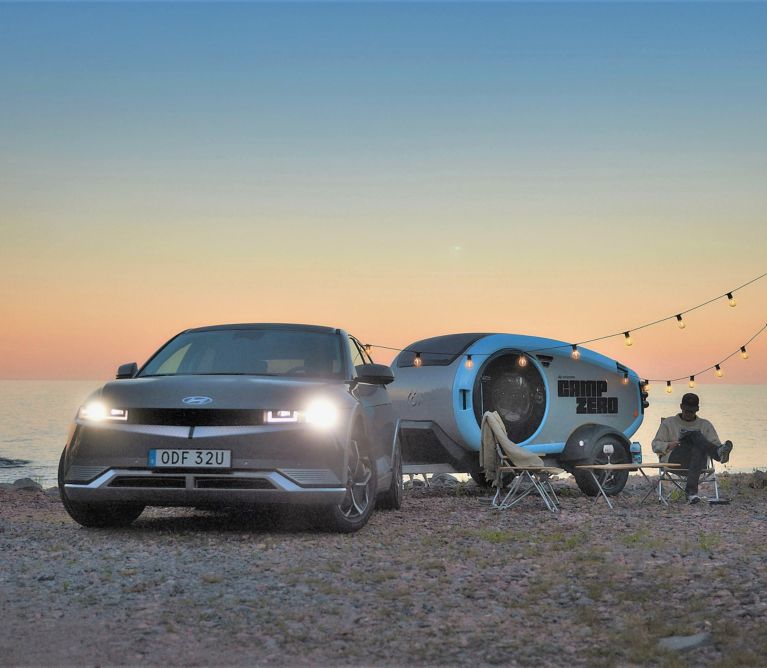- IONIQ 5’s powerful towing capability makes it the ideal vehicle for a zero-emission road trip with a trailer to the great outdoors
- Thanks Hyundai’s Electric-Global Modular Platform (E-GMP), IONIQ 5 offers superior stability when towing trailers and caravans
- Its innovative V2L functionality can charge and power all manner of electrical equipment, giving customers the ability to venture far outdoors
Press material
-
Download
-
Images
Enjoyment of the great outdoors is always a year-round possibility, but now that summer is here the potential to set out on a road trip and take in the wonder and awe it offers is greater than ever. For those town- or city-dwellers wanting to stay outdoors under the stars, lakeside or other natural beauty spot, however, this can often require the need to tow additional accessories, whether that’s a trailer of camping equipment or a full-size caravan.
Thanks to its ample towing capacity, owners of Hyundai’s IONIQ 5, the 2022 World Car of the Year, can enjoy doing exactly that. And because IONIQ 5 is a fully-electric midsize CUV that offers emissions-free travel, they can do so in the knowledge that they will arrive at their destination in one of the most environmentally-friendly ways possible.
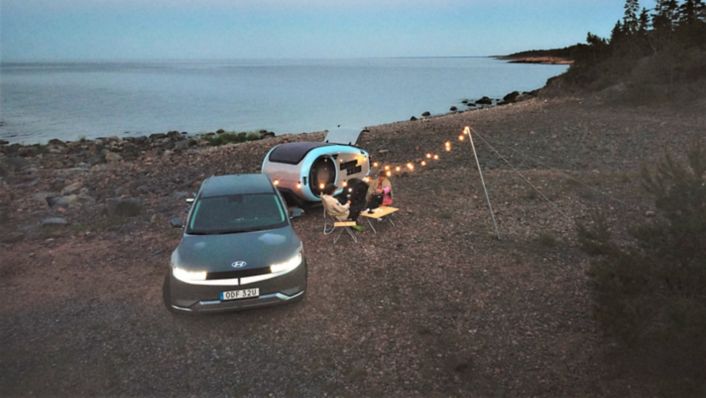
Ready to explore
IONIQ 5 is powerful enough to tow trailers with a gross vehicle weight rating of up to 1,600 kilogrammes – that's more than enough for a 6-berth, 7.5-metre caravan, for example. It also provides 527 litres of cargo space, which increases up to 1,587 litres when the second-row seats are fully folded.
For added versatility, the second-row seats can slide forward up to 135 mm and also be folded in a 6:4 ratio. If that’s still not enough, customers can even enjoy additional storage space with a front trunk that offers up to 57 litres of capacity, which is particularly useful for longer road trips.
Adventurers purchasing the updated Hyundai IONIQ 5 with the 2023 model year will now be able to explore even further on a single charge. Thanks to its new 77.4-kWh battery, the 2WD version of the company’s award-winning, fully-electric midsize CUV with 19-inch alloy rims will offer emissions-free travel of up to 507 kilometres, according to WLTP.
For those who want to keep the adventure going beyond summer, the battery conditioning feature enables IONIQ 5 to automatically adapt the temperature of the new 77.4-kWh battery while travelling, to ensure optimal charging conditions when reaching the charging station. Guaranteeing improved real-life charging performance in cold weather conditions, this function activates automatically when a fast charging point is entered into the vehicle’s navigation system using connected routing.
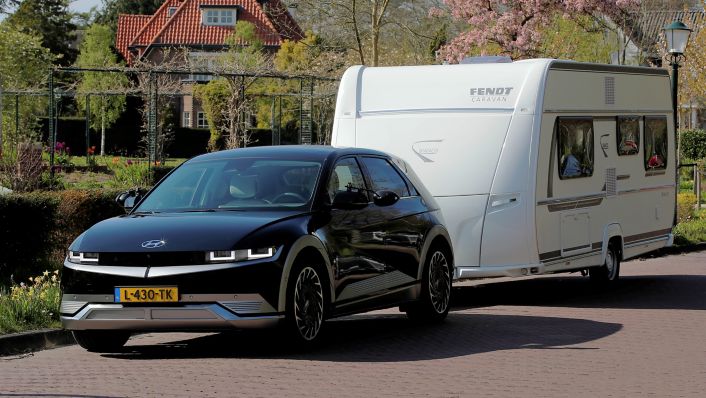
More stability towing
IONIQ 5’s progressive design is not only good at turning heads – it also makes the car perfect for towing. Built upon Hyundai Motor Group’s dedicated Electric-Global Modular Platform (E-GMP), and measuring 4,635-mm long, 1,890-mm wide and 1,605-mm tall on a 3,000-mm wheelbase, it ensures a low, wide stance and the ideal centre of gravity for superior stability when towing.
E-GMP also enables a flat floor allowing for innovative interior design and extra legroom. With the spaciousness of a large passenger car in a midsize CUV, IONIQ 5 will ensure occupants arrive in the great outdoors relaxed and fully attuned with their surroundings.
Adaptive range by push of a button
For drivers experiencing zero-emissions electric travel when towing for the first time, IONIQ 5 offers a feature that enables them to better plan their road trips. Using its telematics system, customers can set the weight category of their trailer and the expected driving range will be adapted accordingly even before the road trip begins. This means IONIQ 5 owners can plan their next charging stop ahead of time.
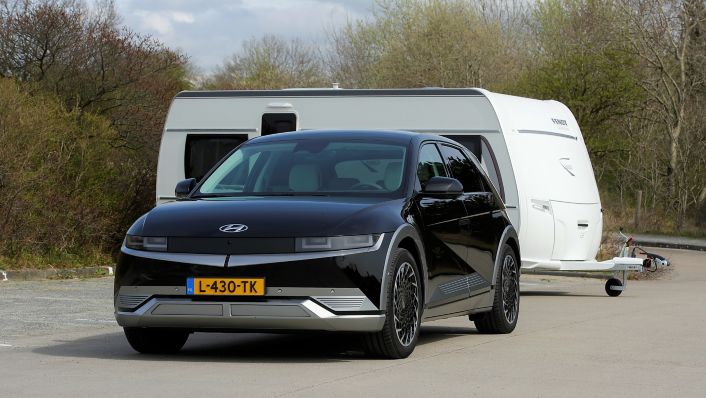
Ultra-fast charging for more quality time
With IONIQ 5’s ultra-fast charging, drivers don’t have to worry about needing to wait for too long before continuing on to their destination. With a 350-kW charger, IONIQ 5 can charge from 10 per cent to 80 per cent in just 18 minutes, while a short five-minute charge can add up to 100 kilometres of driving range (without a trailer), according to WLTP.
Of course, charging time can also be used as an opportunity to take a break from the vehicle’s interior. You might not want to, however, given that IONIQ 5’s spacious, customisable interior really is a home away from home. Its electronically adjustable front seats recline to the optimum angle, offering a luxurious feeling of weightlessness and the perfect opportunity to lay back, relax and even take a nap.
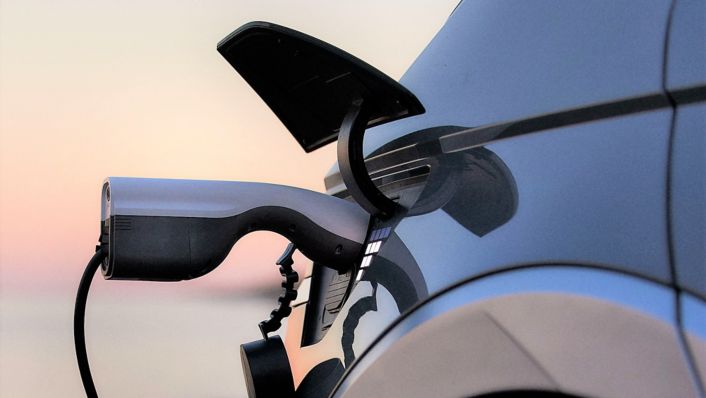
Vehicle-to-Load makes it a power bank on wheels
One of the trump cards that IONIQ 5 holds when it comes to providing customers with the ultimate freedom to explore is its innovative Vehicle-to-Load (V2L) function, which essentially makes it a large power bank on wheels – and an optimum accessory when off-grid and out in the wild. With a V2L port under the rear seats that can be activated when the vehicle is on and one in the exterior charging port (using the supplied converter, even when the vehicle is turned off) that supply up to 3.6 kW of power, this function can be used to charge and power practically anything, from a smartphone or laptop whilst on the go, to a coffee machine, eBike and even an entire caravan.
Thanks to V2L, the environmental impact of an on-road adventure can be reduced even further. It can be used to power a cooking hob, plate and griddle, eliminating the need to use gas, coal or wood when cooking and ensuring the road trip stays virtually 100 per cent emissions-free.
Camp Zero powered by IONIQ 5
To demonstrate the possibilities to drive completely electrically and emission-free, this month Hyundai launched Camp Zero powered by IONIQ 5 in Sweden – an all-electric combination of Hyundai's award-winning electric car and a minimally designed caravan. Featuring the MINK Camper, an aerodynamic, lightweight caravan, Camp Zero provides everything needed for adventures and the ultimate camping experience, including all the electrical amenities, which are of course powered by IONIQ 5 through V2L.
Boasting streamlined design and net weight of only 520 kg, the MINK Camper is equipped with electrical amenities such as an induction plate, espresso machine, kettle, electric fridge/freezer, speaker system and even light loops to set the right mood on a summer’s night. Like IONIQ 5, it offers built-in 230V and USB sockets so campers can connect and charge all conceivable equipment, no matter how far into the wilderness they’ve ventured.
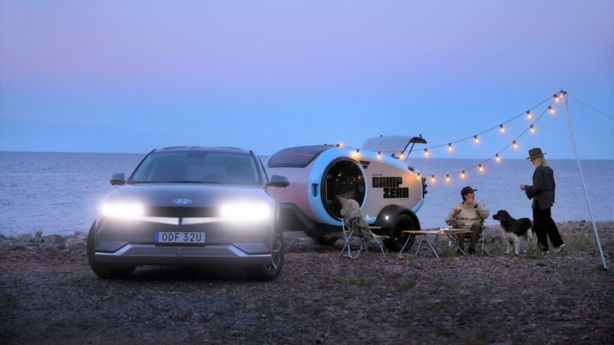
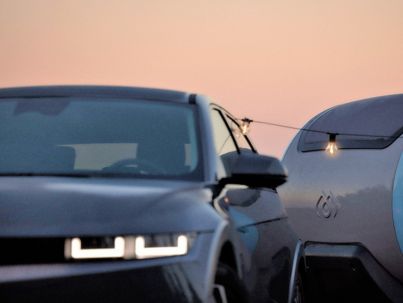
ANWB Tow Car of the Year 2022
IONIQ 5’s towing prowess has also received industry recognition. It was crowned Tow Car of the Year 2022 by the Netherlands’ Royal Dutch Touring Club travel association, known simply as ANWB – making it the first all-electric car to claim this coveted title. Proof, if required, that drivers no longer need have any concern when it comes to EV ownership and towing.
A panel of ANWB’s experts had several criteria when making their selection, including technical innovation, importance for the market, towing capacity and pricing. The jury revealed that it chose IONIQ 5 due to “... its amazing driving characteristics and smart features for caravan users”, including adaptive range and V2L. “It makes transitioning from a traditional to a modern powertrain much easier for caravan users,” they added.
Disclaimer: CO2 and emissions data
- Fuel consumption combined for the Hyundai TUCSON 1.6 T-GDI 48V (150 PS) with 6iMT 2WD in l/100 km: 6.8 - 6.5; CO2 emissions combined in g/km: 154 - 147 (WLTP)
- Fuel consumption combined for the Hyundai TUCSON 1.6 T-GDI 48V (150 PS) with 7DCT 2WD in l/100 km: 6.6 - 6.3; CO2 emissions combined in g/km: 150 - 143 (WLTP)
- Fuel consumption combined for the Hyundai TUCSON 1.6 T-GDI 48V (180 PS) with 6iMT 2WD in l/100 km: 6.7 - 6.4; CO2 emissions combined in g/km: 152 - 145 (WLTP)
- Fuel consumption combined for the Hyundai TUCSON 1.6 T-GDI 48V (180 PS) with 7DCT 4WD in l/100 km: 7.1 - 6.9; CO2 emissions combined in g/km: 162 - 156 (WLTP)
- Fuel consumption combined for the Hyundai TUCSON 1.6 CRDi 48V (136 PS) with 6iMT 2WD in l/100 km: 5.3 - 4.9; CO2 emissions combined in g/km: 139 - 127 (WLTP)
- Fuel consumption combined for the Hyundai TUCSON 1.6 CRDi 48V (136 PS) with 7DCT 2WD in l/100 km: 5.3 - 5.0; CO2 emissions combined in g/km: 139 - 130 (WLTP)
- Fuel consumption combined for the Hyundai TUCSON 1.6 CRDi 48V (136 PS) with 7DCT 4WD in l/100 km: 5.9 - 5.5; CO2 emissions combined in g/km: 154 - 143 (WLTP)
- Fuel consumption combined for the Hyundai TUCSON 1.6 T-GDI (150 PS) with 6MT 2WD in l/100 km: 7.0 - 6.6; CO2 emissions combined in g/km: 159 - 150 (WLTP)
- Fuel consumption combined for the Hyundai TUCSON 1.6 T-GDI (150 PS) with 6MT 4WD in l/100 km: 7.8 - 7.3; CO2 emissions combined in g/km: 178 - 165 (WLTP)
- Fuel consumption combined for the Hyundai TUCSON 1.6 CRDi (115 PS) with 6MT 2WD in l/100 km: 5.5 - 5.1; CO2 emissions combined in g/km: 144 - 135 (WLTP)
- Fuel consumption combined for the Hyundai TUCSON 1.6 T-GDI Hybrid with 6AT 2WD in l/100 km: 5.9 - 5.5; CO2 emissions combined in g/km: 135 - 125 (WLTP)
- Fuel consumption combined for the Hyundai TUCSON 1.6 T-GDI Hybrid with 6AT 4WD in l/100 km: 6.6 - 6.2; CO2 emissions combined in g/km: 149 - 140 (WLTP)
- Fuel consumption combined for the Hyundai TUCSON 1.6 T-GDI Plug-in Hybrid with 6AT 4WD in l/100 km: 1.4; CO2 emissions combined in g/km: 31 (WLTP)
- Electricity consumption combined for the Hyundai IONIQ 5 58 kWh with 2WD in kWh/100 km: 16.7; CO2 emissions combined in g/km: 0 (WLTP)
- Electricity consumption combined for the Hyundai IONIQ 5 58 kWh with 4WD in kWh/100 km: 18.1; CO2 emissions combined in g/km: 0 (WLTP)
- Electricity consumption combined for the Hyundai IONIQ 5 77.4 kWh (19” alloy rims) with 2WD in kWh/100 km: 17.0; CO2 emissions combined in g/km: 0 (WLTP)
- Electricity consumption combined for the Hyundai IONIQ 5 77.4 kWh (20” alloy rims) with 2WD in kWh/100 km: 18.0; CO2 emissions combined in g/km: 0 (WLTP)
- Electricity consumption combined for the Hyundai IONIQ 5 77.4 kWh (19” alloy rims) with 4WD in kWh/100 km: 17.9; CO2 emissions combined in g/km: 0 (WLTP)
- Electricity consumption combined for the Hyundai IONIQ 5 77.4 kWh (20” alloy rims) with 4WD in kWh/100 km: 19.1; CO2 emissions combined in g/km: 0 (WLTP)

